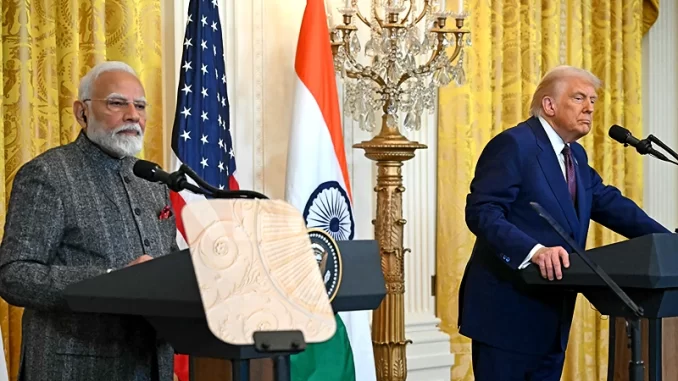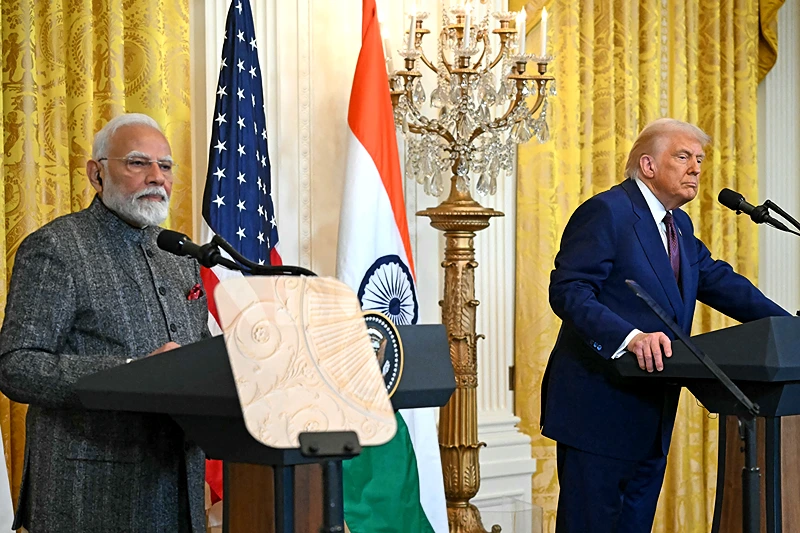

OAN Staff Brooke Mallory
6:17 PM – Thursday, February 13, 2025
As he met with President Donald Trump on Thursday, Indian Prime Minister Narendra Modi arrived with gifts — in the hopes that any trade issues could be avoided, while also discussing a new trade route, U.S. nuclear technology, artificial intelligence policies, and more.
Advertisement
Following a trip to France for an international conference on artificial intelligence (AI), Modi landed in Washington, D.C., on Wednesday.
In addition to meeting with Department of Government Efficiency (DOGE) leader Elon Musk at the 1824 Blair house, he met with Vice President JD Vance before Vance left for his trip to Munich, Germany. In Munich, the VP will speak with European allies on Friday.
One reason that Modi met with Musk was to negotiate Starlink’s debut in the South Asian market. According to reports, Musk and Modi are both cordial with one another, having first met in 2023. The DOGE leader reportedly gifted the Indian PM “a Starship hexagonal heatshield tile.”
Trump also greeted Modi at the White House just hours after he announced a plan for reciprocal tariffs on any nations that impose levies on American products.
The White House highlighted that this trade offensive will improve economic and national security, in addition to making the United States more affluent.
This is the fourth world leader to meet with the GOP president since his second term began.
The meeting between the two leaders, Trump and Modi, was said to have established a stronger relationship between the U.S. and India, Indian officials told the press. New Delhi officials were also hopeful that a reinvigorated strategic cooperation could result from the visit.
Modi, India’s most well-known leader in decades, is known as a popular yet divisive figure both domestically and internationally, according to the BBC.
“Mr. Modi has very staunch admirers and very strong critics. Either you like him or you dislike him,” according to political analyst Ravindra Reshme.
“Trade is by far the most important agenda, with defense and foreign policy taking a secondary position this time around,” said Siddhartha Dubey, a professor of journalism at Bennett University in India, told the American press.
At least currently, no tariffs have been imposed on India, an economy with the fastest rate of growth in the world. However, the stakes are still high.
“This has been one of our strongest international partnerships in recent years,” Dubey added.
With commerce hitting a record $129.2 billion in 2024, the United States is India’s biggest trading partner. At the moment, India has a trade surplus of around $35 billion, according to Fox Business.
In what is being seen as proactive steps to stave off high U.S. tariffs, India is already demonstrating a willingness to lower its own tariffs. India has reduced tariffs on crucial American exports. For instance, India reduced motorbike tariffs this month, which is advantageous to U.S. company Harley-Davidson.
However, India could still be in danger even after taking action to try and allay Trump’s worries. Being one of the “very big tariff abusers,” in Trump’s own words, the president has frequently blasted the country as a “tremendous tariff maker.” Those criticisms were echoed Monday by Kevin Hassett, Trump’s top economic advisor, who said that “India has enormously high” tariffs that serve as an import barrier.
India’s average tariff rate is 17%, which is much higher than the U.S. rate of roughly 3.3% — according to data from the World Trade Organization.
“This is unfair,” Dubey told the press. “And I do not believe that President Trump will turn a blind eye. India has to cut its high tariffs, there’s no question about it.”
Nevertheless, India is still convinced that it can handle Trump’s “America First” policy.
Modi was anticipated to suggest boosting U.S. imports of energy products at the next meeting in order to rectify the trade imbalance. After Trump lifted a moratorium on new export permits, India’s oil secretary says businesses there are eager to buy U.S. liquefied natural gas.
Additionally, India is in a good position to expand its energy commerce with the United States as the country’s fourth-largest importer of liquefied natural gas.
According to Reuters, Modi also negotiated a deal for fighter aircraft engines and the acquisition and co-production of combat vehicles in relation to defense imports. Trump wants India to purchase more security equipment manufactured in the United States, as the nation is the biggest importer of military hardware worldwide.
The pressure comes as Russia and the United States vie for India’s fifth-generation fighter jet contract. On the flip side, New Delhi is working to increase U.S. investment in manufacturing and services, especially in the insurance industry.
Though Modi has recognized that the alliance can be strengthened in a number of crucial areas, such as technology, commerce, defense, energy, and supply chain resilience, Indo-U.S. trade ties have been growing gradually over the years.
Thursday Recap – President Trump and Prime Minister Modi
– The two leaders spoke warmly about the strength of their bilateral relationship while Trump welcomed Indian Prime Minister Narendra Modi in the White House.
– Trump promised to extradite Chicago businessman Tahawwur Rana, who is suspected of taking part in the 2008 Mumbai bombings, while Modi focused on measures to “eliminate cross-border terrorism” in their public statements.
“We are handing over a very dangerous man to India, one who is accused of the 26/11 Mumbai terror attack,” Trump said, rejoicing in the fact that U.S. taxpayers will no longer fund the meals and board of a suspected terrorist.
– Trump criticized India’s tariffs on U.S. goods and emphasized his intention to impose “reciprocal” taxes on US trading partners, despite the two presidents’ cordial ties.
– Restoring the U.S. “as a leading supplier of oil and gas to India” was a mutual agreement between Modi and Trump.
Stay informed! Receive breaking news blasts directly to your inbox for free. Subscribe here. https://www.oann.com/alerts
Advertisements below

